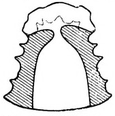Sulcalization
| Sulcalized | |
|---|---|
| ◌ᵓ |
Sulcalization (from Latin: sulcus 'groove'), also called internal rounding, in phonetics, is the pronunciation of a sound, typically a sibilant consonant, such as English /s/ and /z/, with a deep groove running along the back of the tongue that focuses the airstream on the teeth, producing a more intense sound. This is accomplished by raising the sides of the back of the tongue ("lateral contraction") and leaving a hollow along the mid-line. It is not clear if all sibilants are grooved to at least some extent. Catford (1977) observed that the degree of tongue grooving differs between places of articulation as well as between languages; however, no language is known to contrast sibilants based purely on the presence or absence of tongue grooving.
English /ɹ/, which allows various tongue positions without apparent distinction, may also receive its characteristic quality from having a grooved tongue shape. /θ/ has also been reported to show tongue grooving in English, despite being a non-sibilant fricative (Stone & Lundberg 1996).
Albanian /ɫ/, but not /l/, has also been described as being produced with accompanying sulcalization (Lowman 1932: 278).
In phonology and historical linguistics, sulcalization is the development of such a groove in a non-sulcal consonant. For example, close vowels triggered this effect in Japanese, where historic *tu and *ti have become [tsu] and [tɕi], respectively. A similar sound change also took place in the history of the Senufo languages. (The palatalization of *tsi to [tɕi] in Japanese is a different process and does not occur in Senufo.)
Vowels may also be sulcalized, which has been described as giving them a "throaty" sound (Jones 1967: 82). The /ɒ/ vowel of Received Pronunciation, which is normally described as a rounded, is pronounced by some speakers without rounded lips for whom the characteristic quality is rather one of sulcality (Lass 1984: 124).
One scholar has also suggested that the vowel in the RP pronunciation of words like bird, typically transcribed [ɜ], is actually a sulcal schwa, retaining the sulcality of the original rhotic consonant. Accordingly, the realization of the /ə/-element of the centring diphthongs /ɪə̯/, /ʊə̯/, /ɛə̯/ in words such as near, pure and scare, is interpreted as the product of a loss of sulcality (Erickson 2003: 197).
See also
References
- Catford, J. C. (1977). Fundamental Problems in Phonetics. Indiana University Press. ISBN 0-253-32520-X.
- Erickson, Blaine (2003). "On the development of English r". In Minkova, Donka; Stockwell, Robert (eds.). Studies in the History of the English Language: A Millennial Perspective. Walter de Gruyter. pp. 183–206. doi:10.1515/9783110197143.2.183. ISBN 978-3-11-017368-0.
- Jones, Daniel (2009) [1950]. The phoneme: its nature and use. Heffer. ISBN 9780521108072.
- Lass, Roger (1984). Phonology: an introduction to basic concepts. Cambridge University Press. ISBN 9780521237284.
- Lowman, G. S. (1932). "The phonetics of Albanian". Language. 8 (4): 271–293. doi:10.2307/408833. JSTOR 408833.
- Stone, M.; Lundberg, A. (1996). "Three-dimensional tongue surface shapes of English consonants and vowels". Journal of the Acoustical Society of America. 99 (6): 3728–3737. Bibcode:1996ASAJ...99.3728S. doi:10.1121/1.414969. PMID 8655804.


